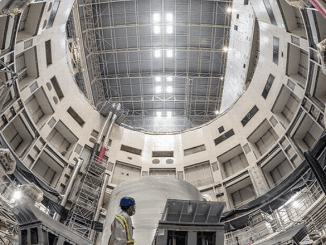
WASHINGTON, DC, April 1, 2020 (ENS) – Vaccine researchers around the world are laser-focused on developing a vaccine to defeat COVID-19, the deadly disease caused by the novel coronavirus that emerged in Wuhan, China in December. With dozens of vaccine projects in the works, a panel of experts met to assess progress and outline the continuing challenges.
In a discussion streamed live Monday by the specialized news website FiercePharma, the scientific lead for the coronavirus program at the National Institute of Allergy and Infectious Diseases’ Vaccine Research Center, Kizzmekia Corbett, said her team is developing a messenger RNA (mRNA) vaccine in partnership with Moderna Therapeutics, based in Cambridge, Massachusetts.

Short for ribonucleic acid, RNA is the nucleic acid used in key metabolic processes for all steps of protein synthesis in all living cells. It carries the genetic information of many viruses.
Vaccine research was launched by scientists in China who shared the genome of a SARS-CoV-2 virus isolate to a global database on January 10.
Like other coronaviruses, SARS-CoV-2 particles are spherical and have mushroom-shaped proteins called spikes protruding from their surface, giving the particles a crown-like appearance. The spike binds and fuses to human cells, allowing the virus to gain entry. Coronavirus infection can be prevented or slowed if this process is disrupted.
While cautioning that timelines are tentative, Corbett said the vaccine may be able to reach healthcare workers in the fall and then a general population in 12 to 18 months. That’s with “every single piece of the puzzle going well” along the way, she said.
The first participant in a clinical trial for a COVID-19 vaccine conducted by the Kaiser Permanente Washington Health Research Institute in Seattle, Washington was given an experimental dose March 16.
This trial is being funded by the National Institutes of Health, NIH. It tests 45 young, healthy volunteers who will receive different doses of the vaccine that was co-developed by the NIH and Moderna.
In all, about 50 vaccines are in early development, and researchers are exploring about 10 different vaccine approaches, said Jim Mayne, vice president of science and regulatory advocacy at the Pharmaceutical Research and Manufacturers of America. For a fact sheet on what various pharmaceutical companies are doing to develop treatments and vaccines for this virus click here.
Anthony Fauci, the director of the National Institute of Allergy and Infectious Diseases, has said that even if initial safety tests go well, “you’re talking about a year to a year and a half” before a vaccine could be ready for widespread use.
In mid-March, China began a Phase I clinical trial of a vaccine against Covid-19, the website Clinical Trials Arena reports.
According to Chinese media, a staff member associated with the government-funded project said that participants are already being vaccinated.
The trial is designed for 108 volunteers aged 18-60 years who are residents of Wuhan. Participants are divided into three groups, each group receiving a different dosage.
The experimental candidate is a recombination vaccine developed by China’s biotechnology company CanSino Biologics in alliance with a research team from the People’s Liberation Army Academy of Military Medical Sciences in Beijing.
According to CanSino, preclinical results showed that the experimental vaccine can induce a strong immune response in animal models, “with a good safety profile.”
Testing Starts at Australian High-containment Biosecurity Lab
Australia’s national science agency CSIRO has begun the first stage of testing potential vaccines to combat COVID-19.
Expected to take three months, the testing is underway at the Australian Animal Health Laboratory in Geelong, Victoria, the high-containment biosecurity facility operated by the Commonwealth Scientific and Industrial Research Organisation, CSIRO.

It is the only such biocontainment facility in the southern hemisphere working with dangerous and exotic pathogens, including diseases that transfer from animals to people.
CSIRO Chief Executive Dr. Larry Marshall said, “Beginning vaccine candidate testing at CSIRO is a critical milestone in the fight against COVID-19, made possible by collaboration both within Australia and across the globe.”
“CSIRO researchers are working around-the-clock to combat this disease which is affecting so many – whether it’s at the Australian Animal Health Laboratory or at our state-of-the-art biologics manufacturing facility – we will keep working until this viral enemy is defeated,” Dr. Marshall pledged.
To prepare for disease outbreaks, last year CSIRO partnered with the Coalition for Epidemic Preparedness Innovations, CEPI, a global group that aims to derail epidemics by speeding up the development of vaccines.
In January, CEPI engaged CSIRO to start working on the virus SARS CoV-2, the coronavirus behind the COVID-19 global pandemic.
To date, CEPI has initiated eight COVID-19 vaccine development projects with Curevac, Inovio Pharmaceuticals, Moderna, Novavax, The University of Hong Kong, The University of Oxford, The University of Queensland and a consortium led by Institut Pasteur to develop COVID-19 vaccine candidates.
On March 26, UK Prime Minister Boris Johnson, who has tested positive for COVID-19, announced a £210 million (US$270 million) boost in funding for CEPI. The announcement followed a virtual conference with G20 leaders and acknowledged CEPI’s recent global call for US$2 billion to progress COVID-19 vaccines through to the manufacturing stage.
Further financial support for CEPI’s COVID-19 efforts has been provided by the governments of Germany, Norway, Denmark, and Finland. CEPI has so far received over $430 million towards its $2 billion funding goal.
This funding will enable CEPI to expand the number of vaccine candidates in development and fund the clinical trials for these candidate vaccines. CEPI’s ambition is to have at least three vaccine candidates, which could be submitted to regulatory authorities for licensure for general use and use in outbreaks.
Global support for vaccine development is slowly getting underway.
On March 18, the U.S Food and Drug Administration, FDA, and the European Medicines Agency, EMA, jointly chaired the first global regulators meeting to discuss regulatory strategies to facilitate the development of SARS-CoV-2 vaccines.
The purpose of this discussion was to promote regulatory convergence with the goal of streamlining global SARS-CoV-2 vaccine development.
The FDA’s Europe Office organized the audio/video conference, which was conducted under the auspices of the International Coalition of Medicines Regulatory Authorities, an international executive-level coalition that brings together key regulators from every region of the world to facilitate access to safe, effective, high-quality products.
More than 60 experts representing 25 agencies and 17 countries participated in the meeting, as well as the World Health Organization.
Peter Marks, M.D., Ph.D., director of the Center for Biologics Evaluation and Research based in Rockville, Maryland, said, “The FDA and the EMA intend to convene additional meetings with other global regulators to enable sharing of data from upcoming clinical trials to help ensure global preparedness and promote regulatory convergence, with the goal of streamlining global SARS-CoV-2 vaccine development.”
The EMA said the agency has had discussions with developers of a dozen potential COVID-19 vaccines. Two vaccines have already entered phase I clinical trials, which are the first trials needed and are carried out in healthy volunteers.
“In general, timelines for the development of medicinal products are difficult to predict,” the European agency said. Based on the information currently available and past experience with vaccine development timeframes, EMA estimates that it might take at least one year before a vaccine against COVID-19 is ready for approval and available in sufficient quantities to enable widespread use.
Copyright Environment News Service (ENS) 2020. All rights reserved.
© 2020, Environment News Service. All rights reserved. Content may be quoted only with proper attribution and a direct link to the original article. Full reproduction is prohibited.



